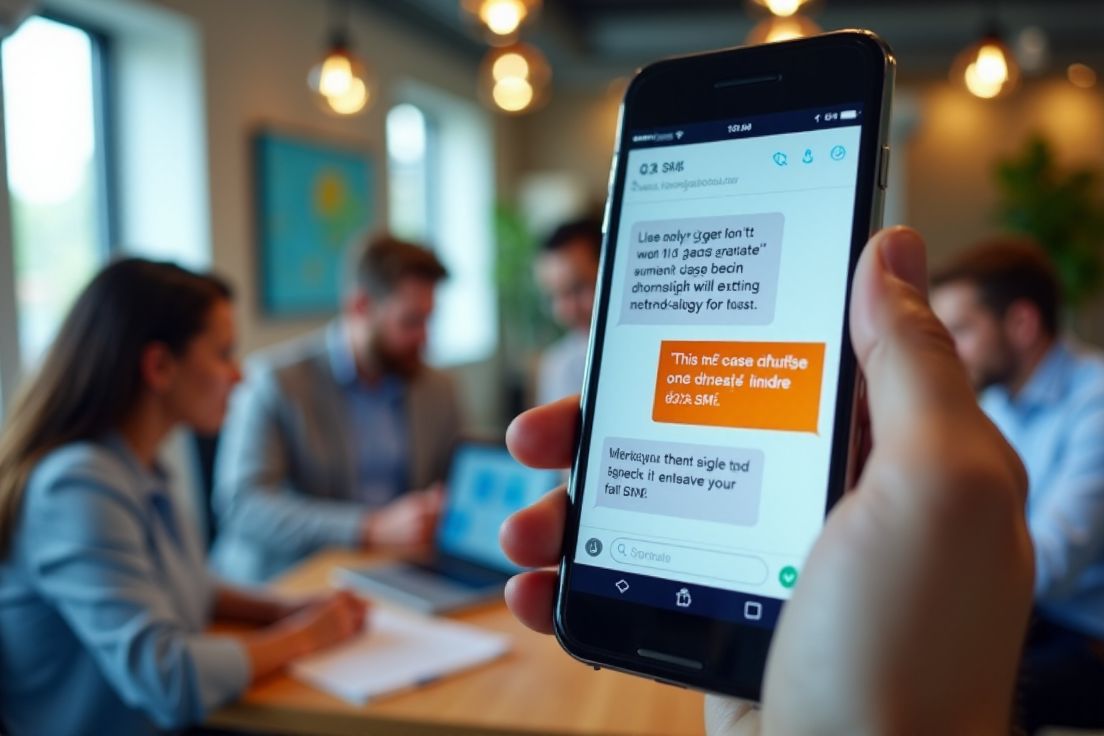Revive Cold Leads with SMS Messaging
SMS messaging has become a powerful way for businesses to connect with their customers. With its high open rates, most people read text messages almost immediately. This makes SMS a great tool for real-time interaction, allowing businesses to keep their audience informed and engaged without any delay.
Not only does SMS help with current customers, but it can also reach cold leads. Companies can send personalized messages to spark interest and rekindle conversations with potential customers who may have lost touch. The simplicity of a text makes it easy for people to respond without feeling overwhelmed.
Harnessing the Impact of SMS Communication

SMS messaging stands out as a powerful tool for engaging customers efficiently. Its high open rates mean that most people read texts almost immediately after receiving them. This real-time interaction facilitates quick responses and immediate connection, allowing businesses to keep their audience informed and engaged without delay.
Moreover, SMS is particularly effective in reaching cold leads.
By sending personalized messages, companies can rekindle interest and initiate conversations with potential customers who might have previously lost touch. The simplicity of a text makes it easy for recipients to engage without feeling overwhelmed.
Furthermore, SMS campaigns can be tailored to fit marketing strategies. Whether it’s sending reminders, special offers, or updates, businesses can create targeted messages that resonate with the recipients interests or past interactions.
This direct approach helps in building relationships that might have otherwise faded.
In today’s fast-paced world, where attention spans are short, the immediacy of SMS communication becomes a major advantage. Businesses can deliver essential information, drive actions, and maintain customer loyalty through concise and engaging text messages. The strategic use of SMS can transform cold prospects into warm leads through effective communication.
Boosting Customer Interaction with SMS Marketing Strategies
To truly boost engagement through SMS campaigns, its essential to focus on personalization. When messages reflect the recipient’s preferences or past behavior, they are more likely to grab attention. For example, addressing customers by their names and sending tailored promotions can make them feel valued and understood. Such strategies encourage them not just to read the messages but also to act upon them.
Personalization is key to enhancing engagement in SMS campaigns. The following table outlines effective strategies and examples for implementing personalized messaging.
| Strategy | Description | Example |
|---|---|---|
| Using Customer Names | Address customers directly to create a personal touch. | Hi Sarah, we’ve got a special offer just for you! |
| Tailored Promotions | Send offers based on past purchases or interests. | Get 20% off on shoes since you bought a pair last month! |
| Birthdays and Anniversaries | Celebrate personal milestones with special messages. | Happy Birthday, Tom! Enjoy a free dessert on us! |
| Location-Based Offers | Send messages relevant to the recipient’s location. | Hi Lucy! Your local store has a flash sale today! |
| Feedback Requests | Ask for opinions based on previous purchases. | How did you like the recent order? Reply with your thoughts! |
| Event Reminders | Remind customers of upcoming events they showed interest in. | Don’t forget the sale event this Saturday, Jake! |
Timing is another critical factor in maximizing response rates. Sending texts during moments when recipients are most likely to engagelike early evening or on weekendscan significantly enhance effectiveness. It’s important to analyze past interactions to determine these optimal time frames.
Incorporating calls to action (CTAs) within messages can drive quicker responses.
To improve the effectiveness of your text messaging strategy, consider the following key points:
- Evaluate historical data on response rates to pinpoint the best times for sending messages.
- Experiment with different time slots to understand peak engagement periods for your audience.
- Utilize urgency in CTAs to prompt immediate action from the recipient.
- Personalize messages to create a stronger connection and boost response likelihood.
- Monitor engagement metrics regularly to refine and optimize your texting schedule.
Simple prompts, like Text back for a special offer or Click here for instant savings, make it clear what the next steps should be. The more straightforward and enticing the CTA, the higher the chances of a customer interacting.
Make sure to track engagement metrics regularly. Keep an eye on response rates, opt-outs, and the overall success of various campaigns.
This data will reveal what works best and help refine future messages, leading to continued improvement in engagement levels.
Lastly, be mindful of the frequency of messages. Sending texts too often can annoy customers and lead to opt-outs. Striking the right balance ensures that your audience remains engaged without feeling overwhelmed.
Crafting Compelling SMS Messages to Attract Attention
To craft SMS messages that truly stand out, focus on being clear, engaging, and concise. Start with a catchy opening line that grabs attention right away. This could be a question, a bold statement, or a special offer. Make the recipient curious enough to want to learn more.
Using emojis can also add a fun element that makes messages more inviting. But use them sparinglytoo many can be distracting. A well-placed emoji can emphasize excitement or urgency, making your message pop.
Ensure every message has a purpose and includes a clear call to action.
Whether its to visit a website, reply to the text, or make a purchase, recipients should know exactly what to do next. Phrasing like “Reply now for exclusive access!”” can create a sense of urgency and encourage quick responses.
Additionally, keep the length of texts in mind.
Short messages tend to be more effective because they are easy to read and digest. Aim to convey your message in 160 characters or less to ensure it’s not cut off. If more details are necessary, consider directing them to a link that has further information.
Another effective strategy is to create a sense of exclusivity.
Phrases like “Just for you,” “Limited time offer,” or “Be among the first” can make recipients feel special and encourage them to engage. This personal touch is especially effective in reviving interest from cold leads.
Lastly, remember to test different styles and content. Regularly review which messages get the best responses and adjust your strategies accordingly.
This way, you can continually improve your SMS messaging approach, making it even more compelling over time.
Effective SMS Timing Techniques to Rekindle Engagement
Timing your SMS messages effectively can make a significant difference in re-engaging cold leads. One important factor is the time of day you choose to send your texts. Late afternoons and early evenings, especially after work hours, tend to be more effective since people are relaxing and open to reading messages. Weekends also show higher engagement rates, as many have more free time to check their phones.
Analyzing previous interactions can provide insight into when your audience is most responsive. This data helps identify patterns and trends that inform the best times to reach out. Testing various time slots over different days can reveal additional peaks in engagement, allowing for a more tailored strategy.
Creating a sense of urgency within your messages can also influence engagement.
Phrases such as limited time offer or hurry, while supplies last encourage quick responses. Its essential to convey a clear message that prompts action right away.
Be cautious with the frequency of your messages. Sending too many texts can overwhelm potential leads and might cause them to opt-out.
Finding the right balance ensures that your audience remains interested without feeling bombarded.
Regularly reviewing and adjusting your timing strategies based on response metrics can lead to better results over time. Keep track of feedback and engagement data to refine your approach continually. Adjusting your timing based on these insights can help keep your messaging relevant and effective in reviving interest.
Harnessing the Potential of SMS Communication

SMS messaging is not just about sending a quick note; it’s about creating lasting impressions and driving meaningful actions. One of the biggest advantages is its direct nature. Unlike emails that can get buried in a crowded inbox, texts arrive in the palm of the recipient’s hand. This immediacy means that businesses can grab attention right away and elicit quicker responses.
Additionally, sending SMS messages allows for a personal touch. Customized content that speaks directly to the recipient’s interests can rekindle relationships with cold leads effectively. Knowing what customers have shown interest in details related to their history encourages them to re-engage. This tailored approach builds a connection that standard emails often fail to achieve.
Moreover, the simplicity of SMS encourages recipients to act promptly. Since messages are typically brief, they can quickly digest the information and respond. Simple calls to action can lead to instant engagement, whether its a reply, a click on a link, or visiting a website. This ease of interaction fosters a sense of urgency that can motivate leads to take the next step.
Utilizing SMS for customer follow-ups can also revitalize interest. A quick message asking how a recent experience went can remind them of previous interactions, making them feel valued and boosting their likelihood to re-engage. This kind of communication is subtle yet effective, helping businesses stay top-of-mind.
Lastly, SMS messaging can be a cost-effective solution for reaching out.
Understanding SMS Marketing Effectiveness
When evaluating SMS marketing effectiveness, one must consider various factors that contribute to the overall success of campaigns. First and foremost is understanding the recipient’s behavior. Analyzing how they interact with previous messages can provide insights into their preferences. This involves tracking open rates, response times, and click-through rates to adjust strategies for better engagement.
Another essential aspect is testing different message formats. Experimenting with text length, tone, and style can reveal what resonates with the audience. For example, short and direct messages may perform better than longer, more detailed ones. Monitoring these results allows businesses to refine their messaging.
Engagement metrics also play a vital role in assessing effectiveness. Keeping track of responses and conversions helps gauge the impact of each campaign. Metrics like opt-out rates are just as important, indicating whether the frequency or content of messages might be off-putting.
Additionally, segmenting the audience enhances the relevance of messages.
By categorizing contacts based on interests or behaviors, businesses can send tailored messages that feel more personalized. This targeted approach improves the chances of rekindling interest among cold leads.
Furthermore, integrating SMS with other marketing channels amplifies its effectiveness. Linking SMS campaigns to email, social media, or online ads creates a cohesive message that can reinforce brand recognition and encourage responses.
Key Benefits of SMS for Re-engaging Cold Leads
One of the main benefits of SMS for re-engaging cold leads is the immediacy it offers. When a text is sent, it goes straight to the recipients phone, allowing them to see it almost instantly. This direct line of communication means businesses can capture attention quickly and encourage spontaneous responses.
Another advantage is the simplicity of SMS messages.
Texts are usually short and easy to read, making it simple for recipients to grasp the information quickly. This lower barrier to engagement can motivate cold leads to take action without feeling overwhelmed by lengthy emails or complex information.
Personalization can also significantly improve the effectiveness of SMS outreach. By tailoring messages to reflect the recipient’s past interests or behaviors, businesses can make the communication feel more relevant and appealing.
This personal touch can be the key to rekindling interest in leads who may have previously disengaged.
Quick and effective follow-ups can reignite interest as well. A simple text after an earlier interaction can remind leads of their previous engagement and encourage a new conversation. Checking in to ask about their experience or offering them a special promotion can make them feel valued and more inclined to respond.
Additionally, SMS can create a sense of urgency that prompts action. Including phrases like limited time offer or act now encourages recipients to respond quickly, as they may miss out on the opportunity. This approach can effectively push cold leads to engage sooner rather than later.
Cost-effectiveness is another benefit worth noting.
Crafting Compelling SMS Messages
Creating SMS messages that resonate requires a blend of creativity and clarity. Start by thinking about what will catch their eye at first glance. An engaging question or an exciting offer can draw them in, sparking their curiosity. Adding emojis can lighten the tone, making the message more appealing, but its best to use them in moderation to avoid distraction.
Every message should serve a purpose. Its vital to include a clear call to action so that recipients know exactly what to do next. Phrases like “Reply now to claim your discount!”” give a clear directive and create urgency.
A well-placed sense of urgency encourages prompt responses and keeps your audience engaged.
Keep the message short. Aim for under 160 characters, ensuring the main point comes across without overwhelming the reader. If more information is needed, direct them to a link where they can find further details.
This keeps communication efficient while satisfying those who want to learn more.
Creating a feeling of exclusivity can also boost engagement. Using phrases such as Just for you or Limited time offer makes recipients feel special, encouraging them to act quickly. This approach can be particularly effective when reaching out to cold leads, making them more likely to respond.
The Power of SMS Messaging

SMS messaging has a remarkable ability to foster immediate connection with customers. Its direct nature means that businesses can engage their audience in real time, prompting faster responses and interactions. This immediacy is crucial when trying to re-engage cold leads, as it gives potential customers the feeling of being directly addressed and valued.
Another significant advantage is the personal touch that SMS offers.
By sending tailored messages based on individual preferences or past behaviors, companies can make cold leads feel recognized. This personalized approach can effectively revive interest and encourage further engagement.
Furthermore, the straightforwardness of SMS makes it easier for recipients to take action. The concise format allows for clear messaging, which can be easily understood and acted upon.
Simple calls to action can lead to quick engagements, whether it’s clicking a link or responding with interest.
Using SMS for follow-ups is another powerful strategy. A thoughtful message checking in after a previous interaction can remind leads of their past experiences, enhancing their sense of connection to the business. Such follow-ups can help to rekindle interest and renew conversations.
The power of SMS also lies in its ability to create urgency. Including phrases like “limited time offer” can motivate recipients to act quickly, pushing cold leads toward engagement. This sense of urgency not only increases the likelihood of immediate responses but also helps to maintain a connection with the audience.
Lastly, utilizing SMS can be a cost-effective approach for reaching potential customers.
With lower investment compared to other marketing channels, businesses can leverage SMS to connect with cold leads without overextending their budget, maximizing their overall effectiveness in driving engagement.
Advantages of SMS for Re-engaging Cold Leads
Utilizing SMS for re-engaging cold leads presents several compelling advantages. One notable benefit is that SMS messages arrive directly on a person’s phone, ensuring they are more likely to be seen quickly. This immediacy allows businesses to capture attention almost instantly, increasing the chance of conversation revival.
Another key advantage is the straightforward nature of SMS.
Text messages tend to be concise and easy to read. This simplicity reduces barriers for cold leads, making it easier for them to digest the information without feeling overwhelmed. Businesses can offer quick updates or exciting promotions in a format that encourages prompt engagement.
Personalization plays a major role in the effectiveness of SMS outreach.
By customizing messages based on a recipient’s past behavior or preferences, companies can create a stronger connection. This personal touch can effectively rekindle interest among cold leads who may feel forgotten.
Moreover, the ability to create urgency helps drive quicker responses. Messages that include phrases like “limited time offer” can motivate recipients to act fast, pushing them to engage sooner rather than later.
This sense of urgency adds excitement and prompts action.
Additionally, SMS can enhance customer follow-up. A brief text following a previous interaction can remind leads of prior engagement, making them feel appreciated. Such messages help to strengthen the relationship and encourage potential customers to re-engage.
Strategies for Crafting Effective SMS Campaigns
Creating effective SMS campaigns involves several essential strategies. One key approach is to focus on clear messaging. Your texts should be easy to understand and get to the point quickly. Avoid using complicated language or too many details that could confuse the reader.
This clarity helps ensure that your message resonates with your audience.
Another important strategy is to maintain a conversational tone. Writing as if you’re talking to a friend can create a more personal connection. Use friendly language and an approachable style, which can make recipients feel more comfortable engaging with your messages.
Effective communication is key to engaging your audience and creating meaningful connections. Here are some strategies to enhance your messaging:
- Be concise and clear in your writing to eliminate any confusion.
- Employ storytelling techniques to make your points relatable.
- Ask rhetorical questions to stimulate thought and interaction.
- Utilize anecdotes or examples to illustrate your messages vividly.
- Encourage feedback to foster a two-way conversation and improve future communications.
Incorporating timely offers can significantly enhance campaign effectiveness. Sending relevant promotions during specific events or holidays can capture attention and spur action. For instance, sending a discount code before a holiday can encourage quick purchases, making your message more impactful.
Additionally, consider segmenting your audience.
By grouping recipients based on their interests or previous interactions, you can tailor messages that are more appealing. This targeted approach ensures that your SMS campaigns speak directly to the recipients’ needs and preferences.
Regularly testing different styles and formats is also critical. Experimenting with various types of content can help identify what works best for your audience.
This can include trying out different message lengths, tones, and even sending times. Monitoring these tests will guide refinements in future campaigns.
Lastly, always include an easy way for recipients to respond. Whether it’s a direct reply to the text or a link to click for more information, ensuring a straightforward next step can drive engagement.
The simpler you make it for customers to respond, the better your chances of reviving interest among cold leads.
Personalization Techniques in SMS Messaging
Personalization techniques in SMS messaging can greatly enhance customer engagement and interaction. One effective method is segmenting the audience based on their behavior and preferences. This allows businesses to send messages that align with individual interests, making the communication feel more relevant. For instance, offers related to products previously viewed or purchased can grab a recipient’s attention more effectively than generic promotions.
Another strategy is to use dynamic content. Customizing messages in real-time based on user data can create a unique experience for each recipient. By integrating collected data, businesses can tailor messages that reflect customer actions, such as browsing habits or purchase history, increasing the likelihood of a positive response.
It’s also helpful to celebrate customer milestones.
Sending messages for birthdays, anniversaries, or loyalty milestones creates a personal connection and reinforces customer appreciation. These gestures can foster a sense of loyalty and encourage engagement with the brand.
Implementing interactive elements further personalizes SMS messaging. Encouraging customers to reply with their preferences, feedback, or choices can enhance the engagement level.
For example, asking them to vote on a new product or service can make them feel included in the decision-making process.
Utilizing location-based services is an additional technique for personalization. Sending messages that include offers relevant to a customer’s physical location can spark immediate interest. This practice shows that the business understands and caters to the customer’s local context.
Frequently Asked Questions
This FAQ section provides answers to common questions about leveraging SMS messaging for effective customer engagement and marketing strategies.
What are the advantages of using SMS for customer engagement?
SMS offers high open rates, immediate delivery, and a personal touch. It’s effective for reaching cold leads, rekindling interest, and facilitating quick responses without overwhelming recipients.
How can I personalize SMS messages?
Personalization can be achieved by using customer names, tailoring promotions based on past purchases, celebrating milestones, and sending location-based offers. The more relevant the message, the higher the engagement.
What timing strategies should I consider for sending SMS messages?
Sending messages during optimal engagement times, like late afternoon or weekends, can improve response rates. Analyzing past interaction data helps identify the best timing for your specific audience.
What role do calls to action (CTAs) play in SMS marketing?
Effective CTAs prompt immediate responses. Clear and enticing CTAs guide recipients on the next steps, such as redeeming an offer or visiting a website, thereby enhancing engagement and conversions.
How should I track the effectiveness of my SMS campaigns?
Monitoring engagement metrics such as response rates, opt-outs, and conversions is crucial. This data helps refine messaging strategies and improve future campaigns based on what resonates with your audience.
What are some best practices for crafting SMS messages?
Keep messages clear, concise, and engaging. Use a catchy opening, include relevant emojis sparingly, and ensure a strong call to action. Testing different styles and formats can also improve effectiveness.
How can I ensure my SMS marketing doesn’t overwhelm customers?
Balancing frequency is key to avoiding customer annoyance. Avoid sending too many texts in a short period, and monitor opt-out rates to adjust your messaging strategy accordingly.
Conclusion
SMS messaging offers a unique opportunity for businesses to connect directly with their customers in real time. Its ability to create immediate interactions can help turn cold leads into engaged prospects. With the right strategies, such as personalization and clear calls to action, companies can effectively encourage responses and foster lasting relationships.
By utilizing SMS campaigns that focus on tailored messaging and timely delivery, businesses can enhance their marketing efforts.





